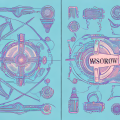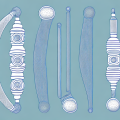Are you looking for a massager to help manage muscle soreness? If so, understanding the differences between percussion massagers and vibrating massagers is key to finding what’s right for you. This article will cover the advantages and drawbacks of each, as well as different types available and factors you should keep in mind when choosing.
What is a Percussion Massager?
A percussion massager is a handheld or free standing device that operates with a motor to provide quick, concentrated pulses of pressure to the skin. It mimics the sensation of a deep tissue massage when used, which is why its often referred to as a ‘power massage’. It can be beneficial in helping to reduce tension, increase circulation and loosen tight muscles.
Percussion massagers are often used by athletes and fitness enthusiasts to help reduce muscle soreness and improve recovery time. They can also be used to help reduce stress and tension in the body, as well as to help improve flexibility and range of motion. Additionally, percussion massagers can be used to help improve circulation and reduce inflammation in the body.
What is a Vibrating Massager?
In contrast to the blunt force of percussion massagers, vibrating massagers provide a more gentle alternative. These devices use a vibration motor to work on tense muscles with tapotement or effleurage strokes. Vibrating massagers can also be used on areas that are sensitive to more forceful massage, as they are much less intense.
Vibrating massagers are often used to help reduce muscle tension, improve circulation, and reduce stress. They can also be used to help with pain relief, as the vibration helps to relax the muscles and reduce inflammation. Additionally, vibrating massagers can be used to help improve flexibility and range of motion, as the vibration helps to loosen tight muscles and increase mobility.
Benefits of Percussion Massagers
The main benefit of percussion massagers is their ability to provide deep relief on target muscles. This action can help reduce chronic pain, stiffness, and soreness significantly. It’s also an effective way to prepare for exercise, as well as to warm up and stretch afterwards. Plus, because of its intensity, it’s much more effective for releasing large knots or increasing range of motion than vibrating devices.
Percussion massagers are also great for athletes who need to recover quickly from intense workouts. The deep tissue massage helps to reduce lactic acid buildup, which can help reduce muscle soreness and fatigue. Additionally, the massage can help to improve circulation, which can help to speed up the recovery process.
Benefits of Vibrating Massagers
Vibrating massagers are better suited for those who suffer from light muscle pain or tension. This is due to the fact that their less intense tapping action only reaches the surface layers of tissues. Some massage specialists believe that this is the ideal type of massage for people experiencing chronic pain because its lighter pressure helps reduce uncomfortable muscle spasms. Also, vibrating massagers are often quieter and more affordable than percussion massagers.
Vibrating massagers are also beneficial for those who are looking for a more relaxing massage experience. The gentle vibrations can help to reduce stress and tension, while also providing a soothing massage. Additionally, vibrating massagers are often easier to use than percussion massagers, as they require less effort to operate.
Potential Drawbacks of Percussion Massagers
The biggest issue with percussion massagers is that they can be too intense for some people, particularly those with sensitive skin or thin body fat layers. This can result in bruising or other forms of physical discomfort. Furthermore, the strong pressure can actually cause a build up of lactic acid in muscle tissue and lead to delayed soreness or even injury.
Additionally, percussion massagers can be quite loud, making them difficult to use in a shared living space. They can also be quite expensive, with some models costing hundreds of dollars. Finally, they can be difficult to use on certain areas of the body, such as the lower back, due to their size and shape.
Potential Drawbacks of Vibrating Massagers
Because vibrating massagers don’t provide as much force as percussion massagers, they may not be able to penetrate deeply enough to reach stubborn knots. Moreover, if not careful, overuse can occur as the milder sensation may cause people to use it for longer periods than advised.
In addition, vibrating massagers may not be suitable for people with certain medical conditions, such as those with pacemakers or pregnant women. It is important to consult with a doctor before using a vibrating massager to ensure it is safe to use.
Different Types of Percussion and Vibrating Massagers
Percussion massagers and vibrating massagers come in a variety of shapes and sizes, including handheld devices and cordless home models. Handheld models are smaller and lighter while more powerful corded models tend to be more expensive and require more space.
Percussion massagers are designed to provide a deep tissue massage, while vibrating massagers are designed to provide a more gentle massage. Both types of massagers can be used to relieve muscle tension, improve circulation, and reduce stress. Depending on the type of massage desired, users can choose from a variety of massage heads and speeds.
Factors to Consider When Choosing the Right Massager
Before buying a massager, consider the factors most suited to your needs such as the size and weight of the device, its intensity and function settings, noise levels, price point, and the type of massage desired (i.e., deep tissue versus surface level).
Tips for Safe and Effective Use of a Massager
To get the most out of your massager experience, it’s best to begin with a lower setting and gradually increase intensity as you become more comfortable with it. Additionally, avoid using a massager over broken skin, joints, or bony areas like shoulder blades. Keep in mind that using a massager too often can create a dependence on it rather than leading to long-term release or improvement in tension or pain, so finding balance is important.





